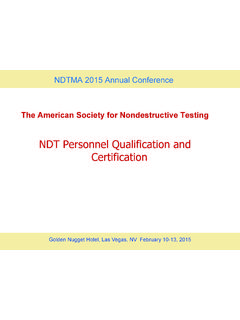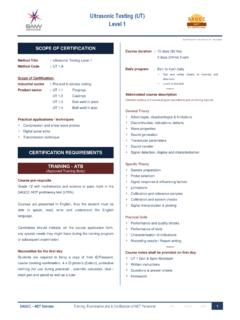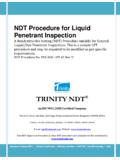Transcription of Experience with Code Cases - Sonomatic
1 Experience with code Cases John R Lilley. C Eng. MInstNDT. asnt Level 3 General Manager, Sonomatic Ltd. Biography John Lilley has been engaged in the NDT industry since 1975, and has held certification to asnt Level 3 since 1984. He has been instrumental in the application of TOFD and other automated ultrasonic inspection technology to industrial applications since 1988. He has written numerous technical publications and has been a regular contributor to codes and standards over the years. He is currently the General Manager of Sonomatic Ltd, and became a Chartered Engineer in 2007. Background code case 2235 was originally issued by the American Society for Mechanical Engineering (ASME) Boiler and Pressure Vessel code (B&PVC) committee in 1996 [Ref 1]. The enquiry asked Under what conditions and limitations may an ultrasonic examination be used in lieu of radiography, when radiography is , and the code case text goes on to define these conditions and limitations.
2 It essentially addresses the following: i. Material thickness ranges and volumetric coverage requirements. ii. Requirement for a documented examination strategy. iii. The requirement for the examination to be carried out in accordance with Section V, Article 4 [Ref 2]. iv. The requirement for acceptable demonstration of performance of equipment, procedures and personnel on a qualification block(s). v. Acceptance criteria based on a combination of flaw height and length measurements which are derived from a linear elastic fracture mechanics procedure. vi. The requirement for automatic computer based data acquisition with data recorded in unprocessed form. vii. Investigation and analysis criteria. viii. Discrimination between surface and sub surface flaws. ix. Rules defining interaction in the case of multiple flaws. Other factors are also addressed, but the above list describes the key elements of the initial code case .
3 There has been extensive discussion through a variety of forums, and the document was revised nine times before being incorporated into the main body of Section VIII in 2008 [Ref 3]. The various revisions have addressed specific refinements although the fundamental document has remained relatively unchanged throughout this process. Along the way, essentially the same code case , with some modification, has been incorporated into the ASME Gas Process Piping code [Ref 4], in the form of code case 181, which was issued in January 2007. The generic term code case is used throughout this paper to refer to the use of UT in lieu of RT as described in Section VIII of the boiler and pressure vessel code , or in code case 181. In both Cases , fracture mechanics based acceptance criteria may be used in lieu of good workmanship criteria. It is important to note that the key difference between conventional and code case acceptance criteria is that the former is based on good workmanship criteria, and the latter is supported by fracture mechanics calculation.
4 A definition is offered here based on personal Experience and interactions with clients, colleagues and partners over a period in excess of thirty year s involvement with relevant projects, standard committees, R&D forums, seminars, workshops, conferences and legal work. Construction codes and standards are intended to ensure that pressure equipment and structures are designed, fabricated and tested to consistent quality standards in the interests of safety and reliability. The early codes stipulated radiographic testing for the detection of flaws within the weld volume. Radiographic testing is however, inefficient for the detection of planar flaws, which must be a) preferentially aligned to the radiographic beam and b) with a gape that exceeds the applicable radiographic geometric un sharpness value. Radiography is efficient however, for the detection of volumetric flaws such as slag entrapment, porosity, undercut, and poor weld profile [Ref 5].
5 It will also detect certain gross planar flaws, especially where these are associated with other types of volumetric flaw. All of the described volumetric flaws/conditions are indicative of poor workmanship and the codes provide very clear limits on what can be defined as unacceptable in terms of quality standards. Rejection levels are not derived from what is considered to be detrimental to the equipment once placed into service, but what is considered to be poor practice in terms of fabrication quality. This quality culture pervades throughout the entire fabrication process in much the same way as a strong safety culture leads to fewer accidents overall. The inference is that if welding procedures are applied diligently and good workmanship principles are upheld, then it follows that the occurrence of cracking and lack of fusion flaws is likely to be minimised. This process has been observed to be effective in that the incidence of boiler/pressure vessel failures has dramatically decreased following the introduction of codes.
6 Attention to detail in construction NDT spills over to control and care of welding consumables, welding procedures, heat treatment, documentation, etc. It is a fundamental aspect of quality control (QC). There is also a psychological influence in that welders justifiably take pride in their work and are inclined to be averse to the stigma of being classified as poor workmen through generating unacceptable levels of repair. Construction good workmanship NDT does not need to have a high Probability Of Detection (POD) because individual flaws which may go undetected are not likely to be detrimental to the use of the equipment in service. This is due to the high level of conservatism embodied within the good workmanship approach. The good workmanship acceptance criteria of Section VIII Div 2 Part 7 (2008 Addenda) includes, but is not restricted to, the following: Cracks and lack of fusion/penetration Not permitted Volumetric flaws Limitations dependent on wall thickness As an example, in the case of a pressure vessel with a wall thickness of 50mm, a 20mm long slag line would be rejectable to these criteria.
7 The slag line may be less than 2mm in cross section and would be expected to be rounded in profile. According to the code Cases , a sub surface, 39mm long by 4mm high, vertically oriented planar crack in a component of the same wall thickness would be permitted. The difference is that the good workmanship criteria are designed to maintain quality standards, thereby implying fitness for service, whereas fracture mechanics based acceptance criteria are designed to eliminate flaws exceeding given dimensions. The performance criteria for the NDT associated with these two approaches are very different. Good workmanship NDT may be less than perfect because it is designed to flag up when the fabrication process is going out of control by picking up systematic flaws (as opposed to detecting all flaws) which are indicative of underlying breakdowns in quality processes. There is less room for manoeuvre with fracture mechanics based acceptance criteria, hence the additional requirement for qualification.
8 Adoption of the code Cases has steadily increased over the years to the point where in certain circumstances, radiographic testing of pressure vessels under construction has fallen away altogether. This process however, has occurred at a time when the industry has gone through: a) a period of changing regulatory influence (less influence from certifying authorities and insurers), b) increased dependency on formal quality processes and c) increased pressure on efficiencies of procurement. These factors in combination have created the environment where it has become prevalent for fabricators and/or inspection service companies to interpret and apply the code Cases according to their own understanding. This has been observed to have occurred without guidance or Experience of working with codes in general, and by people whose native tongue is not English. The situation is not helped by the fact that the code Cases have not been very well written or presented.
9 In the author s Experience , this has led to situations where any ambiguities of interpretation tend to swing markedly towards the interests of the fabricator and/or inspector, often to the detriment of the end client or purchaser of the plant requiring inspection. The consequential effects of this can be very costly in the longer term due to project delays, remediation cost and other project risks. It is suggested that the situation could be improved through stricter control, both in terms of initial specification of the procurement of NDT processes, but also tighter control throughout the fabrication process. The costs associated with quality assurance are very small compared to the project risk involved. The potential benefits of Ultrasonic Testing (UT) in Lieu of Radiographic Testing (RT) for production welding There are certain potential advantages of UT in lieu of RT during the fabrication process.
10 Here is an overview of the more immediate benefits [see also Ref 6]: i. No radiation hazard personnel can work in and around the inspection area ii. No requirement to transport pressure vessels/pipe spools to radiographic compounds iii. Speed. The inspection is completed in a shorter timeframe iv. Potential for improved quality of welding. If applied at the front end of a project, it can be used at the weld procedure and welder qualification stage to optimise the welding process, hence minimising the likelihood of repair. See Figure 1. v. Depth & positioning information provided. Unlike RT, precise repair co ordinates can be provided, minimising the possibility of re repairs through missed flaws Other, less obvious benefits include: i. The data forms a fingerprint for comparison with future in service inspection data. ii. The acceptance criteria of the code Cases are in many Cases more forgiving in terms of acceptable flaw size.



